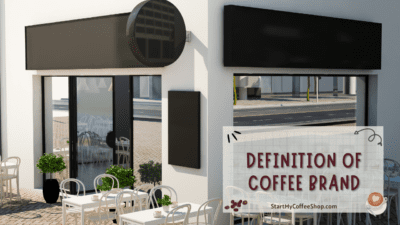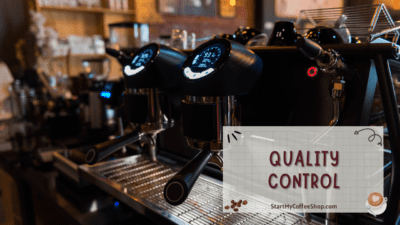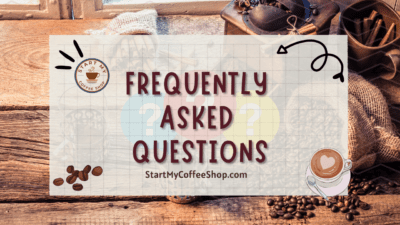Coffee is one of the most popular beverages in the world. The International Coffee Organization reports annual growth in coffee consumption. Entrepreneurs that wish to launch their own coffee companies have a fantastic chance thanks to this trend. But since the coffee market is cutthroat, more than simply a love of coffee is needed to launch a successful coffee brand.
Starting a coffee brand requires sourcing the beans to craft a unique brand identity, getting high-quality equipment, and implementing effective ways to market your coffee brand. With the right strategy and a passion for coffee, anyone can start their own coffee brand and make their mark in the industry.
In this article, I will explore the various factors involved in starting a coffee brand.
Definition of Coffee Brand

Starting a coffee brand refers to creating a product or service that revolves around coffee. This could be anything from selling coffee beans, running a coffee shop, or starting a coffee delivery service. The coffee industry is vast, and there is room for different players to thrive. The importance of starting a coffee brand lies in the fact that it is a growing industry with high demand. A well-executed coffee brand can lead to a fulfilling business venture.
Read more about: Legal Requirements for Running a Coffee Shop: Understanding the Legal Framework
The Current Coffee Industry
The coffee industry has experienced significant growth in the past few years. According to the National Coffee Association, 62% of Americans drink coffee daily. This figure is up from 57% in 2016. The global coffee market was valued at $102.02 billion in 2019 and is expected to grow at a CAGR of 4.22% from 2020 to 2027. These figures indicate that the coffee industry is a viable business opportunity.
Identifying Your Niche in Coffee
To start a successful coffee brand, it is crucial to identify your niche in the market. A niche can refer to a specific area of the coffee industry, such as specialty blends, unique roasts, or a particular target market. By identifying your niche, you can differentiate your brand from the competition and create a unique selling point.
For example, if you choose to specialize in ethically sourced beans, you can attract customers who prioritize sustainability and social responsibility. By honing in on your niche, you can create a strong brand identity and attract a loyal customer base that aligns with your values and offerings.
Identifying the Target Market
The target market is the particular demographic you want to promote your coffee brand to. Making a brand that appeals to your customers requires knowing who your target market is. Based on demographics, psychographics, or location, your target market may exist.
Choosing the Type of Coffee
When starting a coffee brand, it is important to choose the right type of coffee. Arabica, Robusta, and Liberica are the most popular types, each with its own unique flavor profile. Selecting the type that aligns with your brand’s values can help differentiate your business and attract the right customers.
Choosing the Roast Level
Roast level refers to the amount of time that the coffee beans are roasted. There are four main types of roast levels: light, medium, medium-dark, and dark. Each roast level has its unique flavor profile, and it is crucial to choose the roast level that aligns with your brand’s values.
Developing Your Brand

Developing a strong brand is a crucial step when starting a coffee brand. Branding is the way you communicate your company’s values, mission, and identity to your customers. A successful brand strategy will help differentiate your business from your competitors and create a lasting impression on your customers.
A strong brand can also help you attract and retain loyal customers who align with your company’s values and offerings. When developing your brand, consider factors such as your company’s personality, brand voice, visual identity, and messaging. By creating a memorable brand, you can establish a strong presence in the coffee industry.
Read more about: Legal Requirements for Opening a Coffee Shop: Legal Requirements Simplified
Choosing a Name and Logo
Choosing a name and logo is the first step in developing your brand. Your brand name should be easy to remember and relevant to your niche. Your logo should be easy to understand and appealing to the eye. A great example of a well-branded coffee company is Starbucks, with its iconic mermaid logo.
Branding and Packaging Design
Branding and packaging design go hand in hand. The design of your packaging should reflect your brand’s values and appeal to your target market. A well-designed package could be the deciding factor in a customer’s decision to purchase your product.
Creating a Unique Value Proposition
Creating a unique value proposition is an essential aspect of developing your brand. Your value proposition should communicate what sets your brand apart from your competitors. Your unique value proposition could be based on the quality of your coffee, the sourcing of your coffee beans, or your commitment to sustainability.
Sourcing Coffee Beans
Sourcing high-quality coffee beans is a critical step when starting a coffee brand. The taste and quality of your coffee depend largely on the quality of the beans you use.
When sourcing beans, consider factors such as the trade practices of your suppliers, the type of coffee you want to produce, and finding a reliable and consistent supplier. Options such as direct trade and fair trade can also impact your brand’s identity and social responsibility. By sourcing beans that align with your brand’s values and priorities, you can ensure that your coffee stands out and attracts the right customers.
Direct Trade vs. Fair Trade
Direct trade refers to the practice of buying coffee beans directly from the farmers who grew them. Fair trade refers to the practice of ensuring that farmers receive fair compensation for their coffee beans. Both direct trade and fair trade have their advantages and disadvantages, and it is essential to choose the sourcing method that aligns with your brand’s values.
Specialty Coffee vs. Commercial Coffee

Specialty coffee refers to coffee that is graded 80 points or above on a 100-point scale by a certified coffee grader. Specialty coffee is often more expensive than commercial coffee, but it has a unique flavor profile and is typically sourced sustainably. Commercial coffee, on the other hand, is often less expensive but may be sourced from unsustainable or unethical sources.
Finding a Reliable Supplier
Finding a reliable supplier is crucial to ensuring the quality of your coffee beans. It is essential to research potential suppliers and to choose a supplier that aligns with your brand’s values. You should also consider the supplier’s location, shipping times, and pricing.
Read more about: Lean Business Plan Coffee Shop: Sipping Towards Efficiency
Coffee Roasting
Coffee roasting is the process of heating green coffee beans to transform them into roasted coffee beans. The roasting process has a significant impact on the flavor profile of the coffee. Understanding the roasting process, choosing a roasting method, and selecting the equipment needed for roasting are essential steps in starting a coffee brand.
Understanding the Roasting Process
The roasting process involves heating green coffee beans until they turn brown and release their natural oils. The roasting process also creates caramelization and Maillard reactions, which contribute to the coffee’s flavor and aroma.
Choosing a Roasting Method
There are several methods of coffee roasting, including air roasting, drum roasting, and fluid bed roasting. Each roasting method has its advantages and disadvantages, and it is essential to choose a method that aligns with your brand’s values.
Equipment Needed for Roasting
When starting a coffee brand, having the right equipment for roasting is crucial. While the equipment needed depends on the roasting method chosen, essential items include a roasting machine, cooling tray, and destoner. By investing in high-quality equipment, you can ensure that your coffee is roasted to perfection and meets your brand’s standards.
Setting Up Your Coffee Shop
Opening a physical location for your coffee brand can be a great way to attract customers and build a loyal following. When setting up your coffee shop, it is important to consider factors such as location, ambiance, and equipment. Choosing a location that is easily accessible and visible to potential customers is crucial, as is creating a welcoming atmosphere that encourages people to linger and enjoy their coffee.
Investing in quality equipment such as espresso machines and grinders can also help ensure that your coffee is consistently delicious and meets your customers’ expectations. By focusing on these key aspects of setting up your coffee shop, you can create a memorable experience that keeps customers coming back for more.
Choosing a Location
Choosing a location for your coffee shop is crucial to the success of your brand. You should consider factors such as foot traffic, parking, accessibility, and competition when choosing a location. You should also consider the rent and other expenses associated with the location.
Creating a Welcoming Environment

Creating a welcoming environment is essential to attracting and retaining customers. You should consider factors such as the layout, lighting, music, and decor when designing your coffee shop. You should also ensure that your staff is friendly and knowledgeable about your products.
Choosing the Right Equipment
Choosing the right equipment is essential to ensuring the quality of your coffee. You should consider factors such as the grinder, espresso machine, brewer, and water filtration system when choosing equipment. You should also ensure that your equipment is properly maintained and cleaned.
Read more about: How to Start Your Own Coffee Brand: The Aroma of Entrepreneurship
Marketing Your Brand
Marketing is a vital aspect of starting a coffee brand, as it helps to create awareness and attract customers. Social media marketing, email marketing, influencer marketing, and events are all effective strategies to consider when marketing your coffee brand. Social media platforms such as Instagram and Facebook can be powerful tools for showcasing your brand’s personality and engaging with your audience.
Email marketing allows you to build a relationship with your subscribers and keep them updated on your latest offerings. Partnering with influencers can help expand your reach and increase your brand’s visibility. Hosting events such as coffee tastings or pop-up shops can also be a great way to generate buzz and introduce your brand to new customers.
Social Media Marketing
Social media marketing involves promoting your brand on social media platforms such as Facebook, Instagram, and Twitter. You can use social media to showcase your products, engage with your customers, and build brand awareness.
Email Marketing
Sending promotional emails to your subscribers and customers is a part of email marketing. You can use email marketing to promote new products, offer discounts and promotions, and share company news.
Influencer Marketing
Partnering with social media influencers to sell your company is known as influencer marketing. Influencers can expand your audience and strengthen the reputation of your brand.
Events
Hosting events such as tastings, workshops, and competitions can help you build brand awareness and attract new customers.
Maintaining Quality
Maintaining quality is crucial for any coffee brand. It involves implementing quality control measures, ensuring consistency in your product, and regularly maintaining your equipment. Maintaining quality is critical to the success of your coffee brand. With a strong quality control process, consistency in your product, regular equipment maintenance, and cupping sessions, you can ensure that your coffee meets your customers’ expectations and builds a loyal following.
Quality control

It is essential to ensure that your coffee is consistently good and meets your customers’ expectations. To achieve this, it is important to have a quality control process in place that includes regular taste tests and evaluations.
Consistency in your product
Consistency is critical. Customers will expect the same taste and quality each time they purchase your coffee. To achieve consistency, it is necessary to establish standard operating procedures for each step of the production process. These procedures should include precise measurements, brewing times, and temperature controls.
Read more about: How To Start A Coffee Stand: Key Elements To Consider
Regular maintenance of equipment
Regular maintenance of your equipment is also crucial to maintaining quality. Over time, coffee equipment can become worn or damaged, affecting the taste and quality of your coffee. Regular cleaning and maintenance of your equipment, such as your roasting machine and brewing equipment, can help prevent these issues and ensure that your coffee tastes its best.
Summary
Starting a coffee brand requires careful planning and attention to detail. From developing your brand to sourcing coffee beans, roasting, setting up your coffee shop, and marketing your brand, there are several essential steps to take to ensure the success of your brand.
Frequently Asked Questions

Q: How do I source high-quality coffee beans?
A: To source high-quality beans, it is important to research different coffee-growing regions, choose reputable suppliers, and sample different varieties to find the best flavor profiles.
Q: Do I need to have prior experience in the coffee industry to start a coffee brand?
A: While prior experience can be helpful, it is not necessary to have experience in the coffee industry to start a coffee brand. Passion for coffee and a willingness to learn can go a long way.
Q: What are some key factors that contribute to the success of a coffee brand?
A: Key factors include quality of the coffee, unique brand identity, effective marketing strategies, and exceptional customer service. Building a loyal customer base through consistent quality and memorable experiences can also lead to long-term success.
To learn more on how to start your own coffee shop, check out my startup documents here.
Disclaimer: The information provided by StartMyCoffeeShop.com (“The Site”) is for general informational purposes only. All information on the Site is provided in good faith. However, we make no representation or warranty of any kind, express or implied, regarding the accuracy, adequacy, validity, reliability, availability, or completeness of any information on the Site. Under no circumstance shall we have any liability to you for any loss or damage of any kind incurred as a result of the use of the Site or Reliance on any information provided on the Site. Your use of the Site and reliance on any information on the Site is solely at your own risk. This blog post is for educational purposes only and does not constitute legal advice. Please consult a legal expert to address your specific needs. Terms and Conditions. (https://startmycoffeeshop.com/terms-and-conditions/)

Hi! I’m Shawn Chun
My adventure in coffee began when I first launched my first coffee shop back in the early 2000s. I had to figure out so many things on my own and to make it worse within 2 years of opening two large corporate coffee chains moved in just blocks away from me!
As I saw smaller and even some larger coffee shops in the neighborhood slowly lose customers to these giant coffee chains and slowly close up shop, I knew that I had to start getting creative…or go out of business.
I (like you may be) knew the coffee industry well. I could make the best latte art around and the foam on my caps was the fluffiest you have ever seen. I even had the best state-of-the-art 2 group digital Nuova Simonelli machine money could buy. But I knew that these things alone would not be enough to lure customers away from the name brand established coffee shops.
Eventually, through lots of trial and error as well as perseverance and creativity I did find a way to not only survive but also thrive in the coffee/espresso industry even while those corporate coffee chains stayed put. During those years I learned to adapt and always faced new challenges. It was not always easy, however, in the end, I was the sole survivor independent coffee shop within a 10-mile radius of my location. Just two corporate coffee chains and I were left after that year. All told the corporate coffee chains took down over 15 small independent coffee shops and kiosks and I was the last one standing and thriving.
Along the years I meet others with the same passion for coffee and I quickly learned that it is not only “how good a barista is” that makes a coffee shop successful, but the business side of coffee as well.
Hence why I started this website you are on now. To provide the tools and resources for up and coming coffee shop owners to gain that vital insight and knowledge on how to start a coffee shop successfully.
Stick around, browse through my helpful blog and resources and enjoy your stay! With lots of LATTE LOVE!
Shawn







